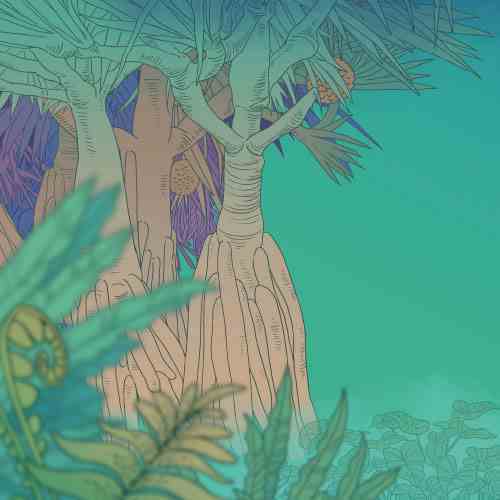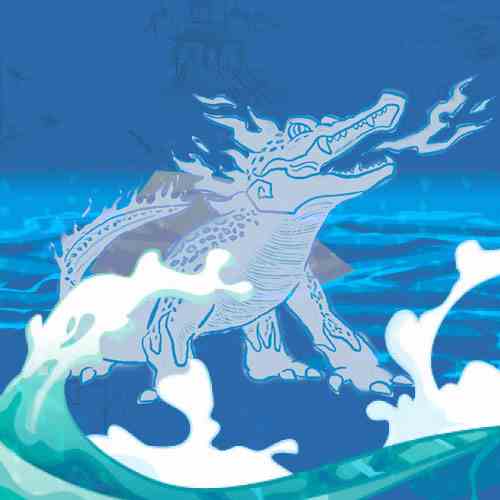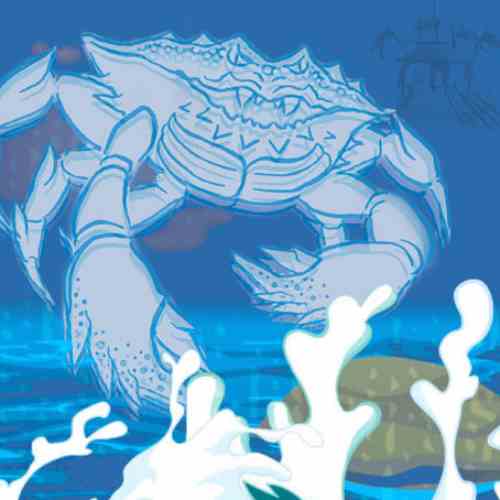17th Century ——
1621-1627 (The reign of Tianqi Emperor)
Legend has it that Buddhist monk Shi Hua-you of Mount Putuo peregrinated through the secluded mountains in Taiwan, and captured a monstrous bull the size of an adult elephant near a river.
1661 (15th year of the reign of Yongli Emperor)
A mythical mermaid was spotted off the coast near Fort Zeelandia, which the Dutch saw as a bad omen. Not long after, Koxinga laid siege to the fortress with his fleet.
1662 (16th year of the reign of Yongli Emperor)
The occurrence of the "Grave Bird Cursing Incident" on Kinmen Island. The Incident was later documented in "The Story of the Ghost Bird" in Lu Ruo-teng's POEMS OF ISLAND LAMENTS.
Qing Dynasty ——
1683 (22nd year of the reign of Kangxi Emperor)
1. The capitulation to Qing Admiral Shi Lang ended the Kingdom of Tungning and brought Taiwan under Qing rule.
2. According to Chang Jih-sheng's JOURNEY TO TAIWAN, it is said that a fire crocodile appeared near the coast of Penghu and dropped dead a few days later.
1697 (36th year of the reign of Kangxi Emperor)
Yu Yong-he crossed the Strait to Taiwan on a mission to mine sulfur in northern Taiwan. He delineated his treacherous journey and many paranormal encounters in SMALL SEA TRAVELOGUE.
1710 (49th year of the reign of Kangxi Emperor)
Sun Yuan-heng published CHI-KAN SYMPOSIUM, depicting Taiwan as a devil's island in his poems.
1786 (51st year of the reign of Kangxi Emperor)
According to Zhou Xi's CHANGHUA COUNTY CHRONICLES, a "demon bird" appeared in Changhua, which was later seen as an omen of the impending Lin Shuangwen Rebellion.
1819 (24th year of the reign of Jiaqing Emperor)
During his tenure as a county magistrate in Taiwan, Yao Ying adjudicated on the "monster harassment" case and ordered the joss of the Wutong deities to be burned and destroyed, as chronicled in "The Ruling of Burning of the Wutong Sinister Deities."
1847 (27th year of the reign of Daoguang Emperor)
Xu Zong-gan arrived on Taiwan as the Taiwan Circuit Intendant and wrote THE COMPLETE WORKS OF SIWEI XINZHAI, which documents Taiwan's folklore and war-related strange tales.
1848 (28th year of the reign of Daoguang Emperor)
In THE EAST SEA JOURNAL, Ding Shao-yi recorded his one-year journey in Taiwan, with local spooky tales included in the chapter "Strange". The book was not published until 1873.
1862 (1st year of the reign of Tongzhi Emperor)
Lin Hao's EAST SEA CHRONICLE reports on a human-faced bovine that spoke prophecies in Sizhangli in Central Taiwan, presaging the truculent Tai Chao-chuen incident.
1894 (20th year of the reign of Guangxu Emperor)
1. Ni Zan-yuan, a Confucian disciplinary teacher in Yunlin County, Taiwan Prefecture, complied the YUNLIN COUNTY INTERVIEW, which included records of local paranormal stories and peculiar customs.
2. Hengchun County Magistrate Chen Wen-wei commissioned Tu Ji-shan to compile the HENGCHUN COUNTY CHRONICLE and Wang Chun-yuan and Qiu Fu-kang to survey local folklore and rural legends.
The Japanese Colonial Period ——
1895 (28th year of Meiji era)
Japanese anthropologist Inō Kanori extensively researched the local customs and aboriginal cultures in Taiwan. His works RESEARCH TRIP AMONG THE PLAINS ABORIGINES and TAIWAN FIELDWORK DIARY document occult legends from across Taiwan.
1915 (4th year of Taisho era)
In 1909, the Special Taiwanese Custom and Practice Research Board established the Savage Section to investigate the aboriginal cultures in Taiwan. It subsequently published BANZOKU CHŌSA HŌ KOKUSHO (INVESTIGATION OF THE SAVAGE PEOPLES) REPORT and other research results in 1915, reporting on the customs of the aborigines as well as a multitude of uncanny stories and anecdotes.
1920 (9th year of Taisho era)
Haruo Satō recounted his three-month trip in Taiwan in SHOKUMINCHI NO TABI (A JOURNEY IN THE COLONIES), of which "Jokai Ōgi Kidan (Strange Tale of the Bridal Fan)", a piece of literature reminiscent of Gothic fiction, was considered by later scholars as of high artistic value.
1921 (10th year of Taisho era)
The Taiwan Nichinichi Shimpo (Taiwan Daily News) published Kataoka Iwao's TAIWAN FŪZOKUSHI (TAIWAN MANNERS AND CUSTOMS), detailing Taiwan's folklore as well as preternatural rural tales. It is currently one of the most important references for those studying Taiwan's paranormal culture.
1923 (12th year of Taisho era)
Sayama Yukichi and Yoshitoshi Onishi published the MYTHOLOGIES OF UNDOMESTICATED SAVAGES, telling of creation myths, indigenous folklore, hero stories, and eerie legends.
1931 (6th year of Showa era)
Hsu Bing-ding began his serial fiction HSIAO FÊNG SHÊN (小封神), telling stories of a battle between gods and demons in Tainan, which is said to be associated with the origin of Guiling Shengmu (Mother Spiritual Tortoise) and Bixi (son of a dragon with the form of a tortoise). It is considered a classic example of early fantasy literature in Taiwan.
1936 (11th year of Showa era)
Compiled by Lee Shying-chuang, TAIWAN MINKAN BUNGAKU-SHŪ (COLLECTION OF FOLKLORE FROM TAIWAN) signified the beginning of modern writers' attention to folklore. The book narrates tales from Taiwan's countryside such as Koxinga performing exorcisms and the treasures of Haloton.
1941 (16th year of Showa era)
Published from 1941 to 1945, MINZOKU TAIWAN (TAIWAN FOLKLORE) was a magazine that introduced Taiwanese folklore to its readers, drawing on a vast collection of preternatural urban legends and stories.
The Post-WWII Period ——
1955 (44th year of the ROC)
NEW SONGS OF SISTER LIN TOU, compiled by Lin Chun-rong and published by Hsinchu's Xing-xin Publishing House.
1956 (45th year of the ROC)
1. The story of Sister Lin Tou was adapted into the Taiwanese-language movie SISTER LIN TOU for the first time.
2. The story of "Sheng Goes to Taiwan" was adapted into a Taiwanese-language movie for the first time.
1958 (47th year of the ROC)
THE TRAGEDY OF KEELUNG ROOM NO. 7, edited by Zhang Yu-cheng, was published by Hsinchu's Zhulin Bookstore.
1964 (53rd year of the ROC)
The Economic Research Office of the Bank of Taiwan published Lian Heng's YATANG ANTHOLOGY, which excerpted a wide array of surreal anecdotes from ancient Taiwanese documents.
1987 (76th year of the ROC)
Zhulin Bookstore published the Taiwanese ballad songbook, SHENG GOES TO TAIWAN.
1988 (77th year of the ROC)
Sima Zhongyuan began to write the "Ghost Stories" series, including GHOST TALK, VAMPIRE, and THE SOUL-HIDING VAT and began hosting supernatural radio dramas, which cemented his image as "Sima Zhongyuan the ghost story teller."
1991 (80th year of the ROC)
Chen Wei-min published A BORED GUY'S MILITARY GHOST STORIES, pioneering the new genre of military ghost stories.
1992 (81st year of the ROC)
1. Zhou Zong-jing, a Tao (Yami) from Orchid Island, published THE YAMI WHO FISHED A RAIN BOOT, which contains myths and paranormal tales from the Orchid Island.
2. Fuxin Bookstore published UNCLE SUN TELLS GHOST STORIES - a children's book series adapted from Chinese and foreign tales of the odd and unusual that was popular among elementary school students.
1996 (85th year of the ROC)
1. Wang Jia-xiang published novels centered on themes of Taiwanese fantasy and history, including MYSTERY OF THE DWARFS (1996) and MÔO-SÎN-Á (2002). Both are works of fiction about the rise and fall of the Negrito people and were based on the author's historical imaginings about this prehistoric culture.
2. Crown Publishing held the "Crown Popular Novel Awards" to encourage horror fiction writing.
1997 (86th year of the ROC)
Husluman Vava published THE LIVING SPIRITS IN YUSHAN: BUNUN FOLKLORE AND MYTHOLOGY - a collection of Bunun myths, legends, and monster stories.
1998 (87th year of the ROC)
1. Syaman Rapongan published THE MYTH OF THE BADAIWAN about the legends of the Tao people of Orchid Island.
2. The supernatural animated film GRANDMA AND HER GHOSTS was released.
2002 (91st year of the ROC)
1. The ten-volume children's picture book TAIWAN INDIGENE: MEANING THROUGH STORIES was published. The collection, curated by Paelabang Danapan, features mythology and monster tales of various Taiwanese indigenous tribes.
2. ChthoniC released the album RELENTLESS RECURRENCE based on the legend of Sister Lin Tou, winning the Best Band Award at the 14th Golden Melody Awards.
2003 (92nd year of the ROC)
Xingzi published the online serial fiction story TAI SUI themed on traditional Taiwanese beliefs, unearthly tales, and legends of local uncanny creatures and deities such as the Môo-sîn-á and Huye.
2005 (94th year of the ROC)
1. The COLLECTION OF HUALIEN COUNTY FOLKLORE (edited by Li Jin-yi) was published. This is a compilation of paranormal stories from Hualien.
2. The first of Div's "Hell Series" novels was published. HELL TRAIN narrates the hijacking of a subway train full of creatures from the underworld.
2006 (95th year of the ROC)
Tomorrow Studio, publisher of the "Handy Books of Tomorrow," invited readers into the horror-fiction world of YI SE GUAN (Miscolored Hall), driving the popularity of horror writers like Seba, D51, Ling Jing, and You Zhen.
2007 (96th year of the ROC)
Seba published the FORBIDDEN SORCERER series, which features stories of paranormal fantasy and horror inspired by various cultural contexts.
2008 (97th year of the ROC)
1. Hu Wan-chwan wrote TYPES AND MOTIFS OF TAIWANESE FOLKTALES, offering an overview of the various types of Taiwanese folktales. This literary work is recognized for its rigorous theoretical framework, archival research, and field work.
2. Neqou Sokluman published PALISIA TONGKU-SAVEQ, which narrates the author's own tribal experiences and Bunun mythology in fantasy novel form.
2009 (98th year of the ROC)
1. Gan Yao-ming published KILLING THE GHOST - a magical realism novel about the occult beliefs, mythology, and folk customs of the Hakka.
2. Badai published SEQALU: BETEL NUTS, CERAMIC BEADS, AND THE YOUNG WITCH - a historical fantasy about Puyuma witchcraft and migration.
3. Ling Jing published the WANDERING GHOST novel series, which was inspired by haunted places and ghost stories from around the world.
2013 (102nd year of the ROC)
Yi Chen published the manga MOSINA, based on the Taiwanese legends of Môo-sîn-á.
2014 (103rd year of the ROC)
1. Lin Mei-rong and Li Jia-kai published THE ANTHROPOLOGICAL IMAGINATION OF MÔO-SÎN-Á - the first monograph dedicated to the study of Môo-sîn-á and the first academic attempt to construct the local metaphysical culture using academic theories.
2. Nakao Eki Pacidal published THE OBLITERATING CURSE TO THE ISLAND, which employs Tsou mythology to introduce indigenous identities.
3. Painter Chaos published the illustrated book, TAIWAN MONSTER TOPOGRAPHY.
2015 (104th year of the ROC)
1. Diverging from Taiwanese folklore's focus on ghosts in paranormal stories, the TAIWAN MONSTER RESEARCH REPORT published by Flâneur Culture Lab contextualized unique Taiwanese tales using the broader lens of "monsters."
2. Ji Yu-ling published STORY OF LINTOU adapted from the Tainan folktale "Sister Lin Tou."
3. The movie THE TAG-ALONG, based on a tale of an eerie, human-like creature roaming the mountains of Taichung, was released.
2016 (105th year of the ROC)
1. Wang Luo-fu published MONSTERS, SPIRITS AND WONDERS: TAIWANESE INDIGENOUS STORIES, a storybook with rich cultural elements drawn from the myths, traditional customs, uncanny legends, beliefs, and rituals of Taiwan's 17 indigenous tribes.
2. Taipei Legend Studio published ON MONSTERS - an investigation of metaphysical culture that concludes with an epistemology of local monsters.
3. Lien Ming-wei published QING FU ZI - a fantasy set in the countryside that won the gold medal in the novel category at the Taiwan Literature Awards.
4. Tēnn Sūn-tshong published the young-adult fantasy TŌA-SŪ-IÂ HŌ-HÉ-KHÌ on the online platform SOSreader with the goal of promoting Taiwanese-language literature.
5. The comics platform Comics Project was founded. The platform has fostered innumerable Taiwanese comic artists, including Nofi, renowned for the comic THE IMPERMANENT GHOSTS and its protagonist Heibai Wuchang and the novel by Infinity Zero, JULY 15TH.
2017 (106th year of the ROC)
1. Ho Ching-yao published GRIM TAIWAN: THREE CENTURIES OF DARK IMAGININGS, which constructed the history of Taiwanese monsters from the perspectives of historical studies and folklore. The book includes excerpts from over a hundred books on Taiwan published between 1624 and 1945.
2. Lin Mei-rong published TAIWAN GHOST TALE, which features a collection of ghost stories gathered from oral interviews conducted across Taiwan.
3. Ji Yu-ling's STORY OF LINTOU was adapted into the television film CIRCLE OF NOOSE.
4. THE TEENAGE PSYCHIC, a television series about a psychic schoolgirl, was aired.
5. Red Candle Games released DETENTION - a horror game with a story structure based on Taiwanese Taoist folklore and the underworld.
6. Taipei Legend Studio released the LEGEND HAS IT novel and board game, which combines elements of Taiwanese monsters, puzzle-solving, and current affairs.
2018 (107th year of the ROC)
1. Ho Ching-yao published the fantasy novel INTONING MONSTERS OF FORMOSA: MELODIES. In addition to cooperating with musicians to create a theme song, the novel has also been adapted into a mobile game app.
2. Xiaoxiangshen published GOLDEN GOBLIN'S MURDEROUS TRICKS - a fictional work covering the suspense, horror, and detective genres that was inspired by the myth of the golden goblin.
3. The National Museum of Taiwan Literature held the first-ever special exhibition on paranormal literature in Taiwan.









